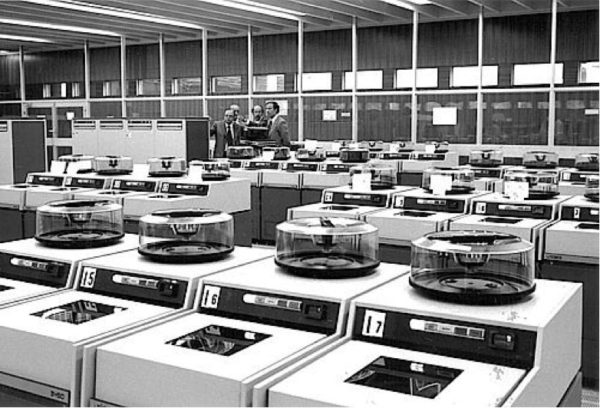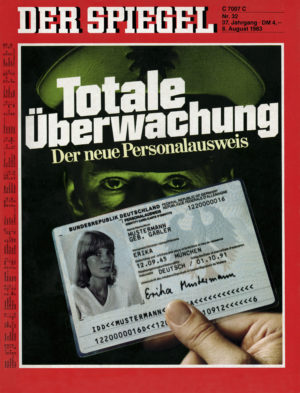Illustration: Jonas Bergstrand
In the eighties and nineties, the right to privacy in Germany was a central demand of the civil rights movement. Millions of people took to the streets and protested against the storage of personal information. Today, few people defend themselves against the daily intrusion into their privacy, although anyone, who opens a Facebook-account, discloses more personal data than in the major state census of the eighties. This essay deals in three parts with the relationship between metadata and privacy. He refers to the origins in the 1970s and tries to explain why Germans have a special relationship to privacy.
In the early 1980s, the government of the Federal Republic of Germany announced a nationwide census on 27th April 1983. This was not unusual in itself. There had been several post-war censuses undertaken to gain more clarity about the dramatic changes in the population. It wasn’t until the 1960s that anyone could say with certainty how many Germans had been killed, fled or lost their homes between 1933 and 1945. Estimates of war victims alone varied considerably between 5.5 and 6.8 million people. The need for these censuses was easy to see and the public largely accepted them without protest. However, by the beginning of the 1980s the situation had changed.
In February 1981, one hundred thousand people protested the construction of a nuclear power plant in Brockdorf, a village of one thousand inhabitants in northern Germany. In November 1981, more than one hundred and twenty thousand people took to the streets of Wiesbaden to rally against the construction of a new runway at Frankfurt Airport. When US President Ronald Reagan visited Germany in June of 1982, a demonstration against NATO’s two decisions was held in the then capital Bonn, involving around half a million people.

peace movement in Bonn 1981. Foto: Creative Commons
Many of the German population protested strongly and exerted considerable pressure on an utterly dismayed German government, through the sheer physical presence of their demonstrations. This was one year before the date of George Orwell’s famous 1984. It followed ten years of RAF terrorism and dragnet investigations, and it was exactly fifty years since the Nazis had come to power. It wasn’t a good time to ask the public for personal information.
Are they even allowed to do that? Computers in society
By the 1970s, another movement had formed on university campuses, through which the protest against censuses reached a new level of significance: the debate about the role of computers in society. This debate had begun in the late 1960s and was essentially about whether new methods of data storage and processing could lead to a surveillance state. The burning question was who should be allowed to collect, store and evaluate which data for what purposes.
One of the leading figures of this debate was Greek immigrant researcher Spiros Simitis, also known as “Prof. Dr. Privacy”. This legal scientist was one of the first to advocate the protection of personal data. He had enforced the world’s first data protection law in Hessen in 1970. At its core, this law remains the goal of all data protection efforts to this day: whoever collects data must provide a binding definition of the purpose for which that data collection is performed. They must further commit to using the data for its defined purpose only and they must comply with this obligation.
But in the very year in which Simitis celebrated the first data protection law, a group led by former journalist Ulrike Meinhof freed terrorist Andreas Bader from a Berlin prison and fled to Jordan where they received military training. In the following years, the group committed “deliberately lethal actions”, as it was called in terrorist jargon, under the name of Red Army Faction. This completely new threat to the state and its elites required new competences and leaders. In retrospect, it is not surprising that a man called Horst Herold became one of the best-known figures in Germany appearing on television more frequently than the Federal Chancellor in the late 1970s.
Herold was a former front-line soldier who grew up among communists in Nuremberg. Throughout his life, he remained sympathetic towards leftist political positions. At the same time, he had a keen interest in technology and an exceptional aptitude for systematically strategic thinking. As Chief of the Criminal Investigation Department of his home town, he was one of the first to recognise the potential of Big Data in terms of investigative success and crime prevention through computer technology.
An algorithm against terrorism?
Around 1970, Herold managed to predict the probability of a new crime being committed in a certain region at a specific time based on past crimes, using a new data-driven “criminal geology”. He achieved great success with this method. As President of the Federal Criminal Police Office (Bundeskriminalamt, BKA), an office to which he was appointed in 1971, he invented “negative dragnet investigation”, which led to the arrest of terrorist Rolf Gerhard Heißler in 1979 by comparing various databases.

Horst Herold explaining the data centre of the Federal Criminal Police Office. Image source: BKA.
At this time, the BKA knew that the terrorists were in Frankfurt and could not pay their electricity bills from their own bank accounts as their names would have appeared on the files of the local utility provider and would have been visible to the police. The list of suspects included all citizens of the city of Frankfurt who paid their electricity bills in cash and whose names could not be verified as real. The investigators ended up with a list of three suspects, one of whom was the terrorist.
The Germans soon became acquainted with the possibilities offered by computers through dragnet investigations, combined with the largest police operation in post-war history. Not only did the state show how much data it stores about its citizens, but also what traces each individual leaves with their data. Many felt unduly criminalised by this method and were left with a sense of mistrust towards the state and computers. Even though negative dragnet investigation rapidly reduced the number of suspects, it initially put many citizens under formal suspicion.
Herold himself regularly stated in public that he wanted to “force terrorists to leave tracks”, which certainly did not help to dispel suspicion. Additionally, the BKA was unable to prove a miracle weapon with its computer analysis. The murder of Hans Martin Schleyer, President of the German Employers’ Association, could not be prevented despite seventy thousand leads from the public, simply because someone had forgotten to enter the crucial lead in the database.
Is privacy a fundamental right?
In the twentieth century, only the government was able to collect sufficient data to bring about social change. Private companies by contrast, played no major role in this respect. While privatisation promised to be one of the possible solutions to counter the overwhelming power of the state, the state continues to have the upper hand to this day. The only way to influence things, then and now, is pressure on the streets. In the pre-Internet era, the public had to take physical action to persuade the government to change direction and because no resistance was to be expected from parliamentary opposition, protesters had to vie for the favour of the courts.
As a key figure on the German data protection scene Simitis (who, ironically, had been in the process of contributing to a book entitled “The Path to the Total Surveillance State” until as recently as 1979), also advised the Federal Government on the drafting of the Census Act. As one of the few progressive experts, he had also expressed constitutional concerns, but the Federal Government had run out of patience and did not take his concerns seriously. Their patience was at an end.

“total surveillence, © DER SPIEGEL 32/1983

Germans think orwellian in 1983. © DER SPIEGEL 1/1983
After a four-year consultation period, the government was keen to finally carry out the census. Any delay, not to mention the failure of this endeavour, would have meant a loss of face for the new conservative government under Chancellor Helmut Kohl, that had only seized power through a vote of no confidence against Chancellor Helmut Schmidt in 1982 and was determined to be re-elected in an early election in 1983.
The government was also unwilling to remove individual questions from the census, because it had already put 370 million German Marks into the budget for the census and wanted to collect as much data as possible in return. Since the census had been initiated by the previous Social Democrat government, the opposition would likewise have suffered a loss of face had it been found that the census violated citizens’ privacy. Resistance could therefore only come from the public, who had to first organise themselves.
An instrumental figure in the organisation of this protest was computer science professor Klaus Brunnstein from Hamburg. Like Sinitis, he had studied at the university of Marburg and moved to Hamburg on completion of his doctorate in Physics, where he co-founded the degree programme in Computer Science. As a young professor, he shared the sceptical attitude of the new generation of students towards the state, authorities and big business. And because he knew about the positive and negative possibilities of data processing, his first introductory lecture in computer science was always about the ethical implications of computer technology.
When the Federal Government’s statisticians defended the census in the early 1980s, arguing that the data collected was anonymous, he and a young graduate proved that all “anonymous” data could easily be traced. All that had to be done was link the data collected with existing data. For example, from the population register to re-associate the anonymous data records with a specific person. Together with several others, Brunstein took his case to the Federal Constitutional Court and filed a lawsuit.
The clarity of the Court’s ruling came as a complete surprise and was just as significant for the protection of privacy as the 1962 “Spiegel Affair“, or the 1971 decision of the Supreme Court concerning the publication of the Pentagon Papers by the New York Times had been for the press. The Federal Constitutional Court banned the census on the grounds that too much personal information would be collected and the data would be stored for too long.
If, according to the Court, the citizens of the Federal Republic of Germany had to assume that the state constantly stores and monitors data about their behaviour, fewer and fewer people would choose to stand out from the crowd. However, a democracy thrives on deviant behaviour and on people who critically question the status quo. The census was therefore not just considered an attack on privacy but also an attack on democracy by the Court. In the opinion of the Court, it blocked deviant behaviour and was therefore incompatible with the constitution.
But the Federal Government did not give in. It postponed the census by four years to 1987 and deleted numerous questions. However, the protest engine had gained momentum. Thousands of leaflets were handed out and telephone chains, which had emerged during the course of the great protest movement of these years, formed a strong network from which citizens’ movements in Germany still benefit today.

Bundesliga match between Borussia Dortmund and the HSV, 1987. picture: imago.
Activists stuck hundreds of blank questionnaires to the Berlin Wall. Shortly before a Bundesliga match between Borussia Dortmund and the HSV at Germany’s largest football stadium, activists wrote the slogan “Boycott and sabotage the census” in the middle of the pitch in huge letters. The groundsman did not know what to do, because the writing could not be removed without damaging the grass. In his despair, he called the Federal President, who came up with the idea to add to and reinterpret the slogan, so that fans would read before the game: “The Federal President: DO NOT boycott and sabotage the census”.
When the census finally took place in 1987, several million citizens joined the boycott or filled out the questionnaires incorrectly. Although the authorities issued fines and initiated criminal proceedings, most cases were eventually closed. The Federal Government could now have finally evaluated its data. But then the Wall came down.
READ THE SERIES:
Part 2: “If we knew that, comrades, we wouldn’t be doing all this.” >>
This post is also available in:
Deutsch (German)







